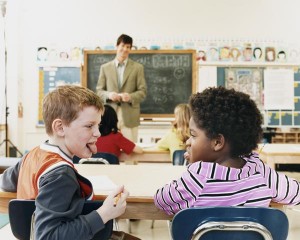 Some children’s behavioral problems in school can be attributed to undiagnosed vision issues. Vision and learning are linked so strongly that if a child has an unknown visual obstacle, it can produce conduct such as:
Some children’s behavioral problems in school can be attributed to undiagnosed vision issues. Vision and learning are linked so strongly that if a child has an unknown visual obstacle, it can produce conduct such as:
- Inattentiveness – Short attention span, not paying attention in class
- Hyperactivity – Does not sit still, constantly moving and fidgeting
- Talks and interrupts during class
- Refuses to read or do homework
- Does not take directions well
- Does not work well alone
- Cannot play or study quietly
- Easily frustrated or angered
- Does not perform up to potential, lack of motivation
- Difficulty organizing and prioritizing work and time
- Forgets homework assignments, loses them or lies about doing them
One in every four children has a visual problem that affects his learning. Some of the more widespread, common vision problems that can result in behavioral issues are:
- Near- and far-sightedness
- Dyslexia – Letter/word reversals, a misdiagnosis which is actually visual spatial disorder
- Astigmatism – Blurs and distorts words
- Strabismus – Crossed or misaligned eyes give conflicting images
- Amblyopia or lazy eye – One eye does most of the work
- Convergence insufficiency – Difficulty focusing the eyes inward to read
- Deficiencies with eye teamwork, tracking, and visual perception
When a child with one or more of these visual difficulties is reading or doing close work, they can experience such symptoms as:
- Headaches
- Eyestrain and fatigue
- Itchy, watery or burning eyes
- Double vision; words that are blurry or move around
- Poor hand-eye coordination
- Dizziness or motion sickness
- Poor concentration, memory, comprehension
It is no wonder children with these vision problems avoid the discomfort of trying to read, write or do homework. Understandably, the disappointment of failure can produce questionable behavior.
As frustration mounts, these behaviors can progress to poor self-esteem, anger, lack of self-confidence, acting out, bullying other children, fighting and other excessive behaviors which can lead a child down the wrong path.
How can you find out if your child has a vision problem hindering his learning? The first step is to have a behavioral optometrist conduct a thorough examination of all areas of vision, including the 17 skills necessary for near (reading) vision. These skills are not tested for in school screenings or with the eye chart which checks only 20-foot blackboard vision. 20/20 vision does not help a child read a book.
If we test your child and find that he has one of the above conditions or another learning-related vision disorder, we offer many forms of treatment:
- Eyeglasses or contact lenses
- Performance-enhancing lenses
- Colored light therapy
- Vision therapy
Our vision therapy and light therapy programs are customized to every child’s specific needs to help improve vision and lessen troubling symptoms. Recreational activities are added to make therapy fun, such as computer games and sports play. Our goal is to alleviate the vision problems that hinder your child from reading, learning, and developing a healthy self-worth.
Last year, we were privileged to help 14 children through vision therapy who were misdiagnosed with learning disabilities and 6 misdiagnosed with ADD/ADHD. To read about other vision therapy success stories, click here.
If you recognize any of the above symptoms or behaviors in your child, please give us a call as soon as possible. Your child does not have to suffer through this alone. We will make every effort to put him back on the right path in school and ultimately in his life going forward.